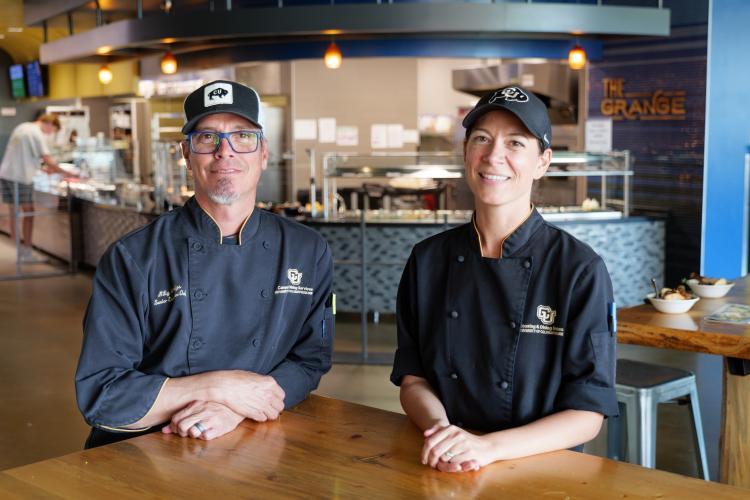
Kale, Yeah! CU Boulder’s Sustainable Dining
It’s a chilly, overcast spring day in Boulder — but you wouldn’t know it from inside the greenhouse at Village Dining Center, where the temperature is always a balmy 65 degrees.
Clad in a baseball cap and an oversized T-shirt, CU Boulder junior Tessa Dempster (EnvSt, Geog’26) is harvesting kale from one of the 137 hydroponic towers that fill the temperate 2,700-square-foot room. She carefully pulls a handful of leafy greens from a vertical stand, snips off the stems and tosses the tender leaves into a plastic bin.
When she’s all finished, this kale — grown in just a few weeks using a water-based nutrient solution — will be washed, spun dry and added to the salad bar in the adjoining dining hall.
“We go, like, 15 feet and — boom! Food production ... done,” she said, grabbing another handful of kale. “It’s definitely lessening the environmental footprint, and it makes you feel like you’re working toward a higher purpose.”
Healthy and Delicious
College food can conjure images of gristly “mystery meat” and suspicious-looking casseroles bathed in the glow of buffet heat lamps. CU Boulder offers a different vision, providing sustainable, nutritious and delicious meals to students — greenhouse-grown lettuces, colorful vegetables, luscious fruits, scratch-made soups, stone-fired pizzas, hearty grain bowls and fresh-baked breads.
The world is taking notice. This year, CU Boulder was rated the No. 1 post-secondary institution for plant-based dining and sustainability on the Humane World for Animals’ 2025 College and University Protein Sustainability Scorecard. In addition, CU was the only university on the list with more than 50% plant-based meals on its menu.
And CU is aiming higher: The university has set a goal of boosting its plant-based menu offerings to 75% by the end of 2025.
Supreme Greens
Campus Dining Services dishes up an estimated 3.5 million scratch-made meals each year, and vegetables play a starring role in several of them. Veggies are a sustainable option since they tend to use less energy, land and water than animal-based foods, and they also produce significantly lower greenhouse gas emissions. They also bring vibrancy, color and freshness to campus dining, according to Eliah Golden, associate director for residential dining and culinary operations for Campus Dining Services.
“This is what allows us to offer so much variety,” said Golden. “I actually shudder at the thought of what a buffet line would look like without vegetables — it would be pretty boring.”
In addition, the university works with local growers and suppliers to reduce the carbon footprint of its meals and support the local economy. CU Boulder prepares 5,000 to 6,000 pounds of dried pinto beans each year (farmed just a few miles away in Longmont) and spotlights seasonal Colorado produce like organic apples from Ela Family Farms, a fourth-generation orchard on the Western Slope.
“We’re supporting great farms and educating students about local agriculture and seasonality — it’s a win-win,” said Billy Kardys, senior executive chef for Campus Dining Services.
Preparing Future Consumers
With healthy offerings on campus, students can make lifelong food choices that are better for themselves and the planet.
This philosophy is shared by members of the Menus of Change University Research Collaborative, a group of colleges and universities using campus dining halls to help shape the food system of the future. CU Boulder has been a member since the collaborative’s inception in 2014, and Golden serves as co-chair of the executive chefs committee.
“We make a huge impact on these incoming ‘consumers,’ as I like to call them,” said Kardys. “When students go out into the world and they’re no longer eating with us, we want them to take these values with them.”
Campus chefs also introduce students to cuisines from around the world.
“We’re with these students at a very formative time in their lives,” said Golden. “Our hope is that they’re going to expand their palate so they have a joy about food, that they’re excited to try new things and international flavors.”
Dining Options for Everyone
For diners with dietary restrictions, allergies, intolerances, religious customs or food preferences, eating out can be a stressful experience.
CU Boulder accommodates many diets, from halal and kosher to vegan, vegetarian and gluten-free. Campus Dining Services also has a registered dietician who can help students — and reassure parents — with dietary questions and concerns.
In 2022, CU Boulder unveiled Libby on the Run, a reimagined version of the Libby Hall dining facility. It’s a full-service, grab-and-go venue that caters to students with four major food allergies: peanuts, tree nuts, gluten and wheat.
“We don’t want anyone feeling like they can’t have a happy and healthy college experience because of food,” said Golden. “We wanted to offer a completely safe zone for folks with those allergies.”
“Continuous Improvement”
Dining will continue to play a vital role as CU Boulder works toward its campus master plan goal of adding 4,400 to 6,000 on-campus beds over the next 15 to 30 years.
Residence One, a new apartment-style residential building under construction north of Boulder Creek, and proposed sister property Residence Two will feature all-electric food service facilities — the first of their kind at CU Boulder. Farrand Hall is also slated for an upcoming renovation, allowing campus dining leaders to reimagine the on-site dining venue, The Alley.

Billy Kardys and Eliah Golden
“We’re going to kick it up like 10 gears and offer a really awesome, quick-service, restaurant-style environment that would be competitive with anything on The Hill or Pearl Street,” said Golden.
In the meantime, Campus Dining Services is experimenting with its first-ever food trailer, a 36-foot-long mobile eatery called “Roaming Ralphie.”
CU Boulder dining staffers also hope to expand their educational offerings, including cooking classes offered out of the teaching kitchen at Village Center. They’re also exploring new sustainability initiatives, such as reusable to-go boxes.
“We have a culture of continuous improvement,” said Golden. “We like to set our own bar, and we always want to be better.”
Photos by Glenn Asakawa; Styled by Chris Caldes


Makes 1 Loaf
Ingredients:
2 teaspoons ground flaxseed
2 tablespoons water
½ cup vegetable oil
1 cup coconut milk
1 ¼ cups sugar
¼ cup (packed) medium firm tofu (crumbles)
1 ½ cups (packed) all-purpose flour
1 teaspoon baking powder
½ teaspoon baking soda
1 ¾ cups shredded sweetened coconut
½ teaspoon cinnamon
½ teaspoon salt
Prep: Spray a 9x5 inch loaf pan and preheat oven to 350°F.
Wet mix: In a bowl, mix flaxseed and water. Stir in oil, coconut milk, sugar, and crumbled tofu.
Dry mix: In another bowl, whisk flour, baking powder, baking soda, coconut, salt and cinnamon.
Combine: Gently fold dry into wet until just mixed.
Bake: Pour into the pan and bake approximately one hour, or until a toothpick comes out clean.

